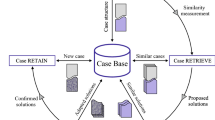Abstract
Reconfigurable machines are used in various manufacturing processes increasingly, so that the system could be adapted to successive market changes, changes in customer requirements, and competition among manufacturers. This makes necessary designing reconfigurable machines that can get into the market as soon as possible. Injection molding machines are an example of an equipment that requires reconfigurability, and the mold is one of the machine modules requiring further attention. This article provides a design methodology that helps designers to decide which mold configuration is appropriate to produce a molded part family. Proposed methodology brings together classical methodologies and design modern tools, and establishes a sequence of activities during the product architecture. This adjustment provides a useful tool in the conceptual definition of the mold architecture and facilitates the preliminary design of molds. Decisions are based on nature and predominant features of conventional products which are manufactured by injection molding. A characterization of common products obtained by molding is proposed as a support database for developing the methodology. In addition, in this work, a case study is developed in order to illustrate how the methodology can be performed. Benefits and advantages of the model are summarized as well.
Similar content being viewed by others
References
Katz R (2007) Design principles of reconfigurable machines. Int J Adv Manuf Technol 34:430–439
Xiaobo Z, Jiancai W, Zhenbi L (2000) A stochastic model of a reconfigurable manufacturing system, part 1: a framework. Int J Prod Res 38:2273–2285
Gupta S, Krishman V (1998) Product family-base assembly sequence design methodology. IIE Trans 30:933–945
Koren Y, Ulsoy A (2002) Vision, principles and impact of reconfigurable manufacturing systems. Powertrain International:14–21
Spicer P, Yip-Hoi D, Koren Y (2005) Scalable reconfigurable equipment design principles. Int J Prod Res:4839–4852
Mesa J, Maury H, Arrieta R, Bula A, Riba C (2015) Characterization of modular architecture principles towards reconfiguration: a first approach in its selection process. J Adv Manuf Technol 80:221–232
Abele E, Wörm A, Stroh C, Elzenheimer J (2002) Multimachining technology integration in RMS. In: 3rd conference on reconfigurable manufacturing. Ann Arbor, Michigan
Koren Y, Heisel U, Jovane F, Moriwaki T, Pritchow G, Van Brussel H, Ulsoy A (1999) Reconfigurable manufacturing systems. Ann CIRP 48:527–540
Abele E, Wörn A, Fleischer J, Wieser J, Martin P, Klöpper R (2007) Mechanical module interfaces for reconfigurable machine tools. Production Engineering - Research and Development 1:421–428
Dieter G, Schmidt L (2009) Engineering Design. McGraw-Hill, Boston
Ulrich K (1995) The role of product architecture in the manufacturing firm. Res Policy 24:419–440
De la O-Ramos R, Borja V, López M, Ramírez A (2010) Product design for variety based on modularity analysis. Revista de Investigación Ingeniería y Tecnología XI(1):57–71
Eppinger S (1994) A model-based method for organizing task in product platform. Res Eng Des 6:1–13
Ericsson A, Erixon G (1999) Controlling design variants: modular product platform. ASME Press, New York
Stone R, Wood K, Crawford R (2000) A heuristic method for identifying modules for product architectures. Des Stud XXI:5–31
Gershenson J, Prasad G, Zhang Y (2004) Product modularity: definitions and benefits. J Eng Des XV(1):33–51
Eppinger S, Browning T (2012) Design structure matrix methods and applications. The MIT Press, Massachusetts
Galan R, Racero J, Eguia I, Canca D (2007) A methodology for facilitating reconfiguration in manufacturing: the move towards reconfigurable manufacturing systems. Int J Adv Manuf Technol 33:345–353
Mahesh O, Srinivasan G (2002) Incremental cell formation considering alternative machines. Int J Prod Res 40:3291–3310
Sarker B, Saiful Islam K (1999) Relative performances of similarity and dissimilarity measures. Comput Ind Eng 37:769–807
Mennig G, Stoeckhert K (2013) Mold-making handbook, 3th edn. Hanser Publications, Cincinati
Colin J, Velou S (2003) Implantation of intacs and a refractive intraocular lens to correct keratoconus. J Cataract Refract Surg 29:832–836
Ferrara P, Torquetti L (2009) Clinical outcomes after implantation of a new intrastromal ring with a 210-degree or arch. J Cataract Refract Surg 35:1604–1608
Ferrara P, Torquetti L (2012) Ferrara ring. In: Textbook on keratoconus: new insights. New Delhi, Jaypee-Highlights, pp 163–174
Marson S, Attia U, Allen D, Tipler P, Jin T, Hedge J, Alcock J (2009) Reconfigurable micro-mould for the manufacture of truly 3D polymer microfluidic devices. Proceeding of the 19th CIRP Design Conference - Competitive Design, pp 343–346
Koc B, Thangaswamy S (2010) Design and analysis of a reconfigurable discrete pin tooling system for molding of three-dimensional free-form objects. Sabanci University Orhanli, Estambul
Author information
Authors and Affiliations
Corresponding author
Rights and permissions
About this article
Cite this article
Pugliese, V., Mesa, J. & Maury, H. Development of a design methodology for reconfigurable injection molds. Int J Adv Manuf Technol 90, 153–166 (2017). https://doi.org/10.1007/s00170-016-9348-z
Received:
Accepted:
Published:
Issue Date:
DOI: https://doi.org/10.1007/s00170-016-9348-z




